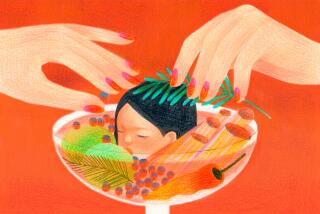Colleges Ask Students to Belly Up to Drinking Class : Health: They hope a major study on alcohol use will lead to an effort on campuses nationwide. A key goal is to change attitudes toward partying.
- Share via
SEATTLE — Even the pros--those students at the University of Washington who know all the particulars about champagne cocktails and “nuclear Jell-O”--have been stumped at the “Bar Lab.”
The tavern atmosphere of Room 242 on the second floor of Guthrie Hall--complete with low lights, stereo speakers, long bar, wide mirror and rows of stacked glasses--makes student volunteers think they are partying at the college’s expense.
After an hour of drinking, some stagger or stumble. There’s a slight slur in speech. Others get so relaxed they shed cloaks of shyness and awkwardness and become the life of the party. A few Romeos even emerge.
So when George A. Parks, research associate at the university’s Addictive Behaviors Research Center, or his colleagues tell the students they have not consumed alcoholic beverages, loud protests erupt.
The trip to the “Bar Lab,” which stands for Behavioral Alcohol Research Laboratory, is one small part of a major study on drinking that Parks and several other professors hope to develop into a college course. The “Alcohol Skills Training Program” would offer students hands-on training and specific skills for responsible drinking. It could be offered as early as the fall semester.
Eventually, the researchers want to make the curriculum available nationwide to colleges that show drinking to be a major problem among students.
“In our view, young drinkers are considered relatively naive or inexperienced with respect to drinking,” Parks said. “Consequently, our skills-training program was developed to provide participants with the necessary coping strategies and information to facilitate safer alcohol use.”
A manager of the Washington, D.C., office of Alcoholics Anonymous was skeptical about the program.
“Most people don’t think they have a problem, particularly young people. Even after they find out they have a problem, they don’t think it’s that bad that they will have to go to all that trouble” of taking a course, he said.
He added, however, that young adults should be taught about why they believe they need drugs.
The official, who asked not to be identified because of the organization’s commitment to anonymity, stressed that the comments represented his own views.
It is estimated that 12 million to 16 million Americans are alcoholics.
Research for the course found that people between the ages of 18 and 25 drink more on average than at any other time of their lives. This puts college students at risk for numerous alcohol-related problems such as poor academic performance, car accidents and date rape.
The Office of Substance Abuse Prevention said in a packet of statistics released for “Spring Break ‘91” that nearly half a million college students drink every day, spending about $4.2 billion each year for alcoholic beverages.
G. Alan Marlatt, director of the Addictive Behaviors Research Center, and John Baer, coordinator of its Alcohol Prevention Study in Seattle, set out seven years ago to test theories that Marlatt and others had developed on the social and cognitive deterrent of alcohol use.
The work was financed by the National Institute on Alcohol Abuse and Alcoholism and focused on creating skills-oriented classes that would be effective in changing attitudes as well as actually showing reductions in alcohol consumption.
“People in our culture are taught that alcohol is something that reduces stress, that will make them feel more comfortable at a party and all that kind of stuff,” said Parks, who serves as a spokesman for the project.
“We’ve shown that those things do influence the amount people drink and if they drink,” he said. “But most of what we’ve been taught about alcohol are not true,”
The myths are numerous.
“We’ve been taught that the more you drink, the higher you get. Absolutely not true,” said Parks. “The more you drink the lower you get. The less you drink, the higher you get. The blood-alcohol content from 0.03% to 0.06% is the time you maximize pleasure, minimize risks and negative side effects, hangovers and so on.”
In general, people with blood alcohol concentration of 0.10% are considered legally drunk.
College students also are creative in their drinking, Parks said.
“They do stuff like nuclear Jell-O--using vodka instead of water in making Jell-O to take to football games. Nobody notices,” Parks said. “The problem with college students is they often drink before they drink. So they drink before the football game, during the football game and after the football game.”
The research involved alcohol abusers. Two types of drinkers were screened out of the program immediately: students already showing signs of physical dependence on alcohol or those with signs of severe psychological disturbance.
Three different types of studies were conducted over the years involving hundreds of students who were paid $5 to $20 to volunteer. The common thread running through each program was that students monitored their drinking by noting on special cards when they drank, how much, with whom and where.
The researchers avoided preaching. Rather, they rely on the Bar Lab to send the message.
“We get two reactions every time” students are told the beverages they’ve consumed are not alcoholic, Parks said. “We get one from the people who are shocked, startled, bewildered, embarrassed. They say, ‘How can this be?’ ”
The other reaction, he said, is from students who claim they knew all along the drinks didn’t contain alcohol, although they never mention those suspicions during the drinking session.
Marlatt said course participants reduced their maximum alcohol consumption by half and maintained that reduction even two years later. Even those involved in what was considered the least-effect study cut their drinking significantly, he said.
“It was surprising to me that we could get this behavior change with a fairly minimal program. In this country, when there’s an alcohol problem, people often tend to think immediately of a maximum program like a standard 28 days in the hospital, whereas possibly there are small things that we could try initially,” Marlatt said.
Parks said researchers are conducting a four-year study of incoming freshmen to further explore the implications of the previous studies.
The researchers are convinced that the university’s program works in part because it doesn’t tell students that they must abstain from liquor, except for those who are alcoholics or physically dependent on alcohol.
“The problem with a lot of programs is they teach people what not to do, rather than what to do,” Parks said. “We want to transform addictions into preferences.”
To those who say that abstinence should be the goal and that reduction in drinking is not meaningful, Parks responds: “If college students are drinking excessively, if you get them to drink at a more reasonable, safer manner that reduces the risks to them and the harm they do to themselves and others, that may be a very significant thing. It may save some lives.”
More to Read
Sign up for Essential California
The most important California stories and recommendations in your inbox every morning.
You may occasionally receive promotional content from the Los Angeles Times.










